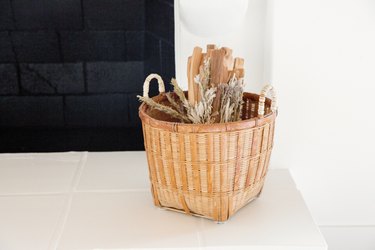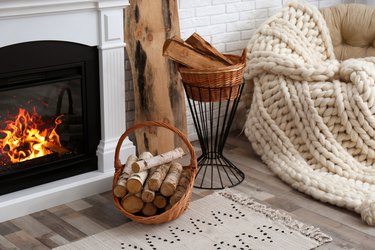
There are few things that compare to feeling the cozy warmth of a glowing wood fire on a chilly winter night. That perfect ambiance is created by a combination of fiery sights, soothing sounds, and distinctive aromas, which is why choosing the best wood for your wood-burning fireplace is so important.
There's no single option that is right for everyone. Whether you plan on chopping down your own trees for firewood or purchasing some logs from the local grocery store, gas station, or a firewood distributor, seek out the right type of wood to ensure you enjoy the best fire possible.
Video of the Day
Video of the Day
Tip
Buying local firewood will not only save you money but will also reduce the likelihood that you’ll inadvertently transport an invasive insect or wood disease into your region. In fact, many states prohibit transporting certain types of firewood across state lines.
The Importance of Seasoning Firewood
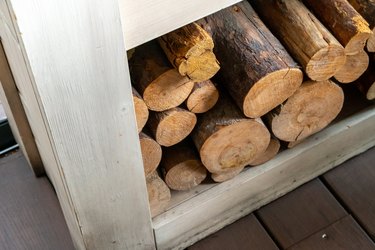
When choosing the best wood for a fireplace, it's important to never use green wood, meaning freshly cut wood that has not been baked and dried in a kiln or seasoned (air dried) in a dry area for a suitable stretch of time. This is because wood should have a very low moisture content before it is burned. Not only does drier wood burn more efficiently than wet wood, but it also emits less smoke than green wood. Burning green wood can significantly decrease air quality levels in your home and may even damage your fireplace.
Store-bought wood should either be kiln-dried or seasoned. Keep in mind that kiln-dried firewood lights easier and burns hotter than seasoned wood, making it a nice product to use in your fireplace, but it usually costs more.
If you chop your own wood, you'll need to place it somewhere out of the rain and snow to season it before use. The time frame for seasoning wood varies based on the type of wood. Oak can take up to two years to dry out, while maple typically takes about six months. Because wet wood is easier to split than dry wood, chop your logs into usable pieces before stacking it for storage. Then, tuck the chopped wood away under a shelter until it's dry.
Properly seasoned wood feels dry to the touch, is lighter than it was when it was first cut, has darker ends, and shows some visible cracking. If your wood steams and hisses when you burn it, then it is still too wet to use and needs to be seasoned longer.
Hardwood vs. Softwood
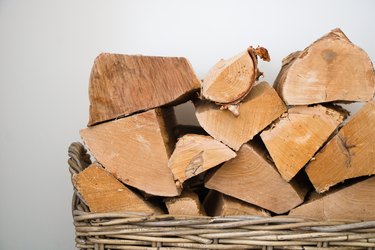
When comparing hardwood and softwood for your fireplace, it all comes down to creosote. This is a chemical that builds up in fireplaces and can cause chimney fires if not regularly cleaned. While creosote buildup is a serious concern and should not be taken lightly, the common adage that softwoods produce creosote is simply untrue. What is true is that wet wood, no matter the variety, will smoke more, thus producing more creosote. Because softwoods burn easier, many people burn them without fully seasoning them until they are sufficiently dry. When hardwoods and softwoods are properly seasoned prior to use, softwood creates no more creosote than hardwood.
That being said, while hardwoods and softwoods are both equally safe for burning in an indoor fireplace, softwoods are not the best choice for maintaining a fire because they burn quicker. Hardwoods, including ash, beech, birch, elm, and oak, are typically denser and contain less resins, meaning they burn longer, hotter, and cleaner, though they may be more difficult to get started. That is why softwoods, such as Douglas fir, pine, and cedar, are best reserved for use as kindling to help catch the longer-burning hardwood on fire.
Considerations for Choosing Wood for Your Fireplace
Generally speaking, the denser and drier a piece of wood, the longer and hotter it will burn. While no two trees will produce exactly the same quality of firewood, scientists have managed to come up with some calculations on the average Btu (British thermal units) produced by a typical cord of each type of wood, with each cord containing 128 cubic feet of wood. These heat values can help you compare the efficiency of one type of wood with another as well as help compare the efficiency of a wood-burning fireplace or wood stove versus a gas or electric heating appliance. Of course, a wood's heat value, the amount of heat it releases while burning, is not the only factor that makes a wood good for a fireplace.
Aside from the number of Btu a particular kind of wood generates, you should consider how easily it catches fire, how many sparks it produces, how easy it is to split, how much smoke it emits, how long it burns, how much it costs, how it smells, and how readily available it is in your area. In many cases, it is a good idea to combine a variety of types of firewood to balance factors such as aroma, longevity, and affordability.
The Best Types of Wood for Your Fireplace
1. Oak
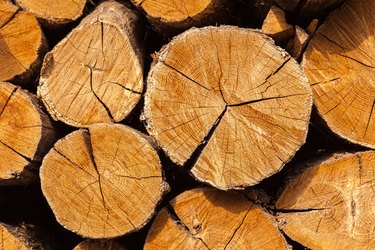
Heat output: 24.6 - 30 million Btu per cord
Burn time: Long
Ease to ignite: Difficult
There are many types of oak, and all of them can be considered among the best types of wood for a fireplace. They are all long-burning and produce little smoke and few sparks. Gambel and white oak are both particularly long-burning oak varieties that produce a lot of heat, while red oak is on the other end of the spectrum. Oak burns so long that if you do not extinguish it, you may still have a few coals left for rekindling in the morning.
Oak logs are also relatively easy to split, so it's easy to work with if you need to chop your own logs or break store-bought logs into smaller pieces. Best of all, oak trees are plentiful and grow throughout the country, so this wood is readily available nearly everywhere at reasonably affordable prices.
On the downside, oak has a high moisture content, so it needs to season for one to two years before use. Also, because it takes so long to get burning, you'll need to use it in combination with other woods to get your fire started and to start feeling warm in a reasonable amount of time.
2. Hickory
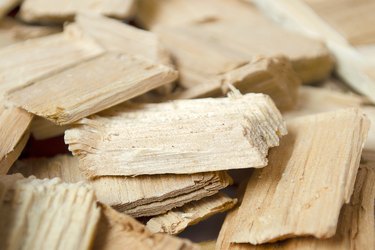
Heat output: 27.7 million Btu per cord
Burn time: Long
Ease to ignite: Easy
One of the most common types of wood used in fireplaces, hickory has a woodsy smell that most people associate with barbecues because cooking with it adds a nice flavor to food. Hickory wood burns hot for a long period of time. Unlike oak, it's easy to light, can be seasoned in less than a year, and is reasonably lightweight. A cord of hickory is at least 500 pounds lighter than a cord of oak. And as a bonus, while it isn't prone to sparking, hickory produces a delightful crackling sound to give your fire an even more rustic feel.
Unfortunately, hickory mostly grows in the Midwest and the Eastern United States and is not affordable or easy to find in other regions.
3. Hard Maple
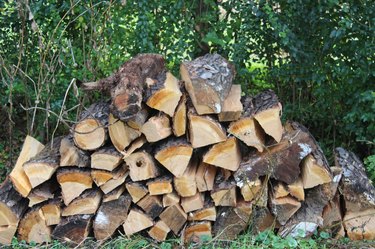
Heat output: 24 million Btu per cord
Burn time: Long
Ease to ignite: Difficult
Also known as sugar maple or rock maple, hard maple wood emits a pleasant aroma, little smoke, and few sparks. Like oak, it is readily found throughout the U.S., though it can be relatively expensive in many areas. If you're cutting your own maple wood, a notable benefit is that it only takes about six months to season. As an additional benefit, like hickory, maple wood can add a pleasant flavor to foods if you cook in the fireplace.
While maple can burn for a long time and even remain burning throughout the night, it takes a long while to get going, so it's best to use it in combination with another type of wood for kindling.
4. Ash

Heat output: 20 - 24 million Btu per cord
Burn time: Long
Ease to ignite: Difficult
Ash wood has a very mild aroma, little smoke, and few sparks. It takes an average of a year to season, is easy to split, and produces a long-burning, reliable flame. While it is widely available throughout most of the U.S., ash is not readily available on the West Coast.
5. Birch
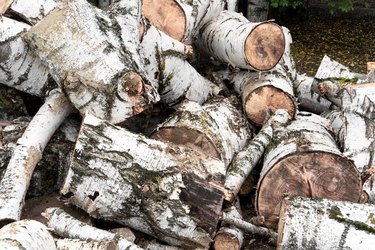
Heat output: 20.8 million Btu per cord
Burn time: Short
Ease to ignite: Easy
While it isn't the longest-lasting firewood, birch wood starts easily, heats quickly, and the bark makes excellent kindling when properly seasoned. It is reasonably affordable and gives off a comfortable amount of heat. However, because it burns quickly, you'll need to combine it with a longer-burning wood, like oak, or keep adding more firewood to keep your fire burning. Unfortunately, birch is typically only available in the Northern U.S.
6. Apple Wood
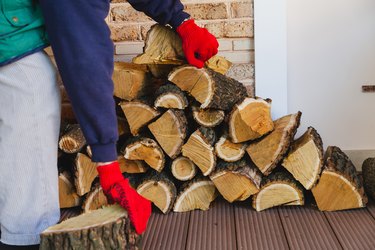
Heat output: 27 million Btu per cord
Burn time: Long
Ease to ignite: Difficult
Even if you've never used it, you probably know that apple wood is particularly fragrant, which is why it is so commonly used for cooking (apple wood smoked bacon, anyone?). It produces a notably pleasant aroma in fireplaces as well, while emitting high heat, few sparks, and little smoke. That being said, apple wood is highly desired, and though apple trees may be found across America, there's simply not enough supply to keep up with the demand, meaning it costs a pretty penny.
While it may be nice to add a log of apple wood along with the rest of your firewood to enhance your fire's aroma, it's simply not practical for most people to have a fire made purely from apple wood. Aside from the relatively high price, apple wood is difficult to get burning, so it is best used with a faster-burning wood.
7. Cherry

Heat output: 20.4 million Btu per cord
Burn time: Short
Ease to ignite: Easy
Like apple wood, cherry wood is fragrant and great for cooking, producing minimal smoke and sparks. Cherry wood does not produce quite as much heat as apple wood and is more expensive than oak or maple. That said, it is less expensive than apple wood, so it is an affordable option if you're looking to enhance the olfactory appeal of your fire.
Unfortunately, cherry wood is not readily available throughout the U.S., with most production occurring on the West Coast and in the Northwest as well as in Michigan and Pennsylvania.
Types of Wood to Avoid
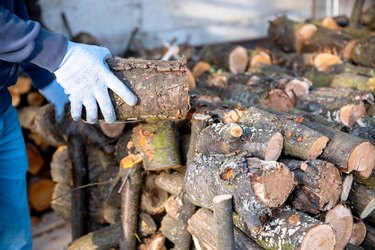
The most important thing to keep in mind when choosing firewood is to only use clean, unpainted, untreated wood to avoid releasing dangerous chemicals into your home, including arsenic. For the same reason, you should never use driftwood, which has a high level of salt content and can release carcinogenic chemicals when burned.
Be cautious while using wood that contains excess sap, most notably pine, since sap creates more smoke while burning, which can result in excess creosote. While it's fine to use a few small pieces of these woods as kindling, never burn a whole pine log or a log of a similarly resinous wood in your fireplace, as it can result in dangerous levels of creosote buildup.
